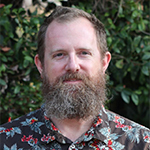Luke Miller
 Department of Biology
Department of Biology
Assistant Professor, Biology
Office/Lab: SDSU Main Campus, Physical Sciences 150A/150
Phone: 619-594-5391 (office)/619-594-3122 (lab)
Email: luke.miller@sdsu.edu
Miller, L.P. & W. W. Dowd. (2019). Repeatable patterns of small-scale spatial variation in intertidal mussel beds and their implications for responses to climate change. Comparative Biochemistry and Physiology – Part A 236: 1-11. https://doi.org/10.1016/j.cbpa.2019.06.016
Miller, L.P. and W.W. Dowd (2019). Dynamic measurements of black oystercatcher (Haematopus bachmani) predation on mussels (Mytilus californianus). Invertebrate Biology 138 (1) 67-73. http://doi.org/10.1111/ivb.12240
Miller, L.P. and W.W. Dowd (2019). Dynamic measurements of black oystercatcher (Haematopus bachmani) predation on mussels (Mytilus californianus). Invertebrate Biology 138 (1) 67-73. http://doi.org/10.1111/ivb.12240
Miller, L.P. and W.W. Dowd (2017). Multimodal in situ datalogging quantifies inter-individual variation in thermal experience and persistent origin effects on gaping behavior among intertidal mussels (Mytilus californianus). Journal of Experimental Biology 220: 4305-4319. http://dx.doi.org/10.1242/jeb.164020
Gleason, L.U., L.P. Miller, J.R. Winnikoff, G.N. Somero, P.H. Yancey, D. Bratz and W.W. Dowd (2017). Thermal history and gape of individual Mytilus californianus correlate with oxidative damage and thermoprotective osmolytes. Journal of Experimental Biology 220(22): 4292-4304. http://dx.doi.org/10.1242/jeb.168450
Helmuth, B., F. Choi, A. Matzelle, J.L. Torossian, S.L. Morello, K.A.S. Mislan, L. Yamane, D. Strickland, P.L. Szathmary, S.E. Gilman, A. Tockstein, T.J. Hilbish, M.T. Burrows, A.M. Power, E. Gosling, N. Mieszkowska, C.D.G. Harley, M. Nishizaki, E. Carrington, B. Menge, L. Petes, M.M. Foley, A. Johnson, M. Poole, M.M. Noble, E.L. Richmond, M. Robart, J. Robinson, J. Sapp, J. Sones, B.R. Broitman, M.W. Denny, K.J. Mach, L.P. Miller, M. O’Donnell, P. Ross, G.E. Hofmann, M. Zippay, C. Blanchette, J.A. Macfarlan, E. Carpizo-Ituarte, B. Ruttenberg, C.E. Peña Mejía, C.D. McQuaid, J. Lathlean, C.J. Monaco, K.R. Nicastro and G. Zardi (2016). Long-term, high frequency in situ measurements of intertidal mussel bed temperatures using biomimetic sensors. Scientific Data 3: 1-11. http://dx.doi.org/10.1038/sdata.2016.87
Early, R., B.A. Bradley, J.S. Dukes, J.J. Lawler, J.D. Olden, D.M. Blumenthal, P. Gonzalez, E.D. Grosholz, I. Ibanez, L.P. Miller, C.J.B. Sorte & A.J. Tatem (2016). Global threats from invasive alien species in the twenty-first century and national response capacities. Nature Communications 7. http://dx.doi.org/10.1038/ncomms12485
LaScala-Gruenewald, D. E., L. P. Miller, M. E. S. Bracken, B. J. Allen & M. W. Denny (2016). Quantifying the top-down effects of grazers on a rocky shore: selective grazing and the potential for competition. Marine Ecology Progress Series 533: 49-66. http://dx.doi.org/10.3354/meps11774
Miller, L. P. & J. D. Long (2015). A tide prediction and tide height control system for laboratory mesocosms. PeerJ 3: e1442. http://doi.org/10.7717/peerj.1442



